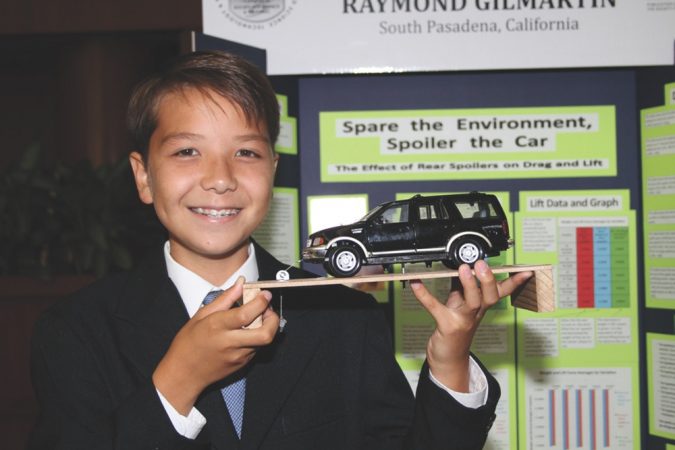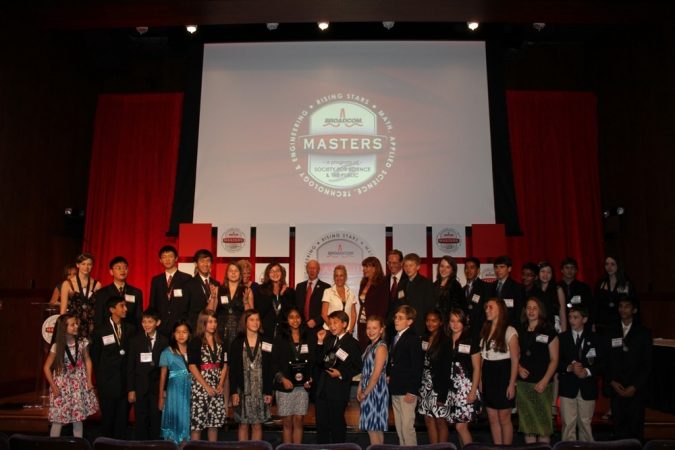Car-crazy kid wins Broadcom competition
First place at middle-school MASTERS event goes to an eighth grader who studied automotive spoilers

A 14-year-old car enthusiast earned the top award at the second annual Broadcom MASTERS competition (MASTERS is an abbreviation for Math, Applied Science, Technology and Engineering for Rising Stars). The eighth-grader — Raymond Gilmartin from South Pasadena, Calif. — received an educational award of $25,000 after cruising through days of engineering enigmas, science stumpers and math mysteries.
Being named the top winner left Gilmartin “excited and overwhelmed,” he said. Participating in the competition has been “the greatest thing that’s happened to me. I made a lot of friends and learned a lot.” His win was announced at an October 2 ceremony in Washington, D.C. The award was provided by the Samueli Foundation (a nonprofit organization based in Corona del Mar, Calif., that was started by Broadcom founder Henry Samueli).
“Broadcom is a company about science and innovation,” said Scott McGregor. He’s president of Broadcom Foundation, which funds the competition. “This is a way to encourage and inspire the innovators of the future.”
One-quarter of Gilmartin’s winning score was based on his original research. It was a project he called “Spare the Environment, Spoiler the Car: The Effect of Rear Spoilers on Drag and Lift.” The young researcher studied how different sizes and shapes of spoilers change the amount of drag that cars experience. A spoiler is a device applied to the body of an automobile — often a sports car. It reduces the friction, or “drag,” that wind exerts on a vehicle. Drag slows a vehicle, requiring it to burn more fuel.
Gilmartin built a six-foot wind tunnel in his house and tested various combinations of model cars and hand-carved wooden spoilers. The result of these tests demonstrated that some kinds of rear spoilers on sport utility vehicles, or SUVs, should work better than others at reducing a drivers’ fuel use.
The other portion of Gilmartin’s winning score came from a gauntlet of science challenges. Beginning on September 30, this year’s 30 Broadcom MASTERS finalists were divided into teams. Each team was instructed to design and build a model house to withstand strong gusts made by a giant fan, to test various biofuels for their energy potential and to develop a vehicle restraint system (along the lines of a seat belt or air bag) to protect a passenger against the dangerous forces associated with a car crash (in this instance, the “passenger” was that science-fair standby — an egg).
“This year’s Broadcom MASTERS finalists have taken on projects that have the potential to improve our environment, our health, our communities,” said Elizabeth Marincola, president of Society for Science and the Public, which administers the Broadcom MASTERS competition and publishes Science News for Kids. “Our finalists tonight exemplify what our students can do if given the right encouragement, direction and support.”

Jessika Baral, 13, took home the Marconi/Samueli Award for Innovation — and $10,000. Inspired by a family full of eyeglass-wearers, she designed a gadget that flashes LED lights in the periphery (the edges of her vision). After a few weeks of practice with the device, Baral’s family, classmates and neighbors in Fremont, Calif., saw improvements in their peripheral vision.
First and second place awards of $3,500 and $2,500 (plus an iPad) were given in four areas of the competition — science, technology, engineering and mathematics. These awards are to be spent toward attending a summer camp with a research focus.
- First prize in science went to Shixuan Justin Li of Lynn Haven, Fla. Nicole Odzer of North Miami Beach, Fla., placed second.
- First prize in technology went to Daniel Lu of Carlisle, Mass. Anirudh Jain of Portland, Ore., took home a second place award.
- First in engineering was Chase Lewis of Chapel Hill, N.C.; second was Carolyn Jons of Eden Prairie, Minn.
- Maria Elena Grimmett of Jupiter, Fla., took first place in mathematics, with Maya Patel of The Woodlands, Texas, taking second.
For demonstrating a high spirit of camaraderie during the science challenges, Cassie Drury of Louisville, Ky., and Mabel Wheeler of Orem, Utah, won Rising Stars Awards. These include a trip to the largest international precollege science competition, Intel ISEF. It will take place in Phoenix, Ariz., next May.
This year’s crop of finalists also included 13-year-old twin brothers — Shashank Dholakia and Shishir Dholakia of Santa Clara, Calif. Together, they tracked the movements of two stars in the sky. Maura Clare Oei, a 14-year-old surfer from Hebron, Conn., developed a way to capture energy from waves. And after a run-in with a rabid skunk in her hen house, 13-year-old Texas rancher Paige Gentry of San Angelo developed various types of wild-animal baits that might be spiked with a rabies vaccine. (Skunks, she discovered, prefer chicken.)
As a special prize, each of the 30 finalists and their teachers will have a newly discovered near-earth asteroid named for them. None of these asteroids appears on a collision course with the Earth, quipped Jenifer Evans of MIT’s Lincoln Laboratory as she presented the award.
Power Words
asteroid Rocky and sometimes metallic remnants of a time when the solar system was forming more than 4 billion years ago. Ranging in size from small boulders to objects hundreds of kilometers in diameter, most orbit within a vast region between Mars and Jupiter. Some orbits, however, may pass very close to Earth’s.
biofuel A fuel — usually a liquid — made from organic materials, such as manure, plant litter (such as straw and stubble), or food scraps. These fuels can be used for heating or to drive engines.
drag Force that slows an object’s movement through fluids, such as water or air.
engineering The application of science to the design of structures, devices and processes.
LED An abbreviation for light-emitting diode. It’s a type of semiconductor device that emits light when electricity passes through it.
peripheral vision Ability to see things on the far left- and right edges of one’s field of view.
spoiler Device applied to the body of an automobile — usually in the rear and often on a sports car. It reduces the slowing action of friction exerted by wind as a vehicle moves.
vehicle restraint A safety system designed to hold occupants of a vehicle in place (so they aren’t propelled through windows or into the frame of a vehicle) during a collision. Seat belts and air bags are examples of vehicle restraints.